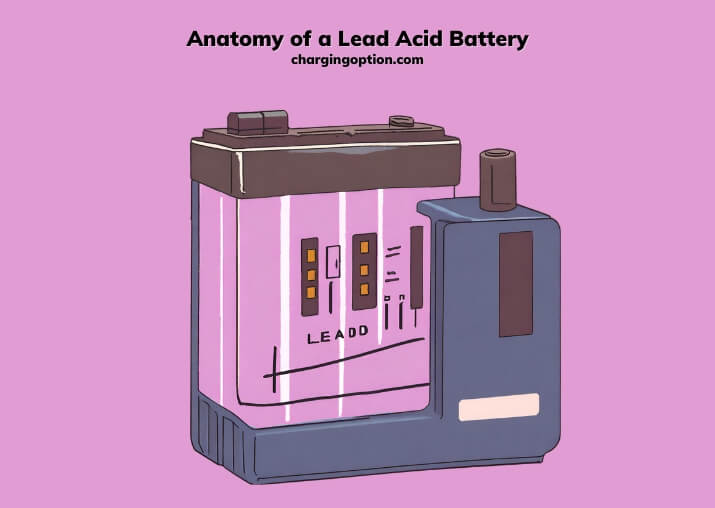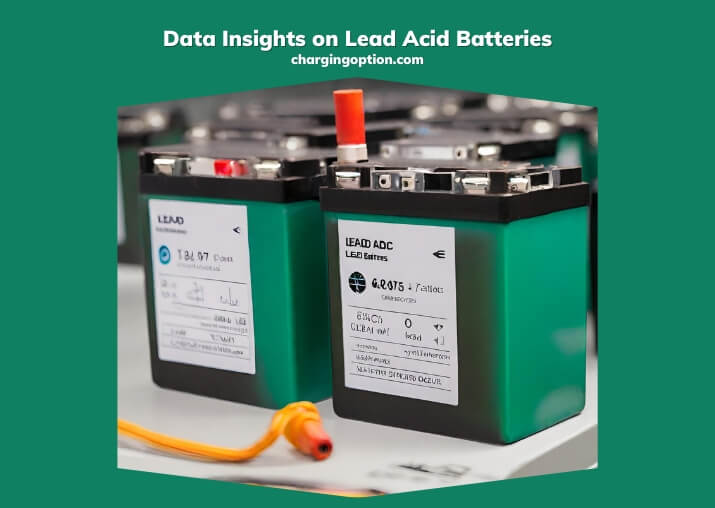During the charging process of a lead-acid battery, lead dioxide is formed at the positive plate. This process is integral to the battery’s ability to store and release electrical energy.
Lead-acid batteries, known for their reliability and cost-effectiveness, play a pivotal role in various applications. The typical lead-acid battery formula consists of lead dioxide (PbO2) as the positive plate and sponge lead (Pb) as the negative plate, immersed in a sulfuric acid (H2SO4) electrolyte. This setup is clearly depicted in a lead-acid battery diagram, which shows the arrangement of these components within the battery casing.
The functioning of a lead-acid battery involves electrochemical reactions at the anode and cathode. During discharge, the anode sees the conversion of lead (Pb) to lead sulfate (PbSO4) while the cathode involves the transformation of lead dioxide (PbO2) to lead sulfate (PbSO4), releasing energy in the process. The reverse occurs during charging, where lead sulfate is converted back to lead and lead dioxide.

The electrolyte, a solution of sulfuric acid and water, plays a crucial role in these reactions. It facilitates the movement of ions between the anode and cathode, enabling the battery to function effectively. Understanding the lead-acid battery reaction is key to optimizing its performance and longevity.
The process of charging and discharging a lead-acid battery is a delicate balance. Proper management of this cycle is essential to maintain the battery’s health and ensure its efficient operation.
For those interested in a deeper insight into the workings of lead-acid batteries, including their chemical reactions, structural components, and operational principles, the detailed article below offers an in-depth look.
Lead Acid Battery Charging – Element Formation Explained
The Chemical Dynamics of Lead Acid Battery Charging
Basic Chemical Reaction in Charging
Let’s talk about what happens inside a lead acid battery when it’s charging. It’s like a little chemical dance where lead sulfate and water are transformed. On the positive side, lead sulfate turns into lead dioxide, while on the negative side, it reverts to pure lead. This dance is not just fascinating; it’s the core of how these batteries store and release energy.
The Function of Lead Dioxide in Storing Energy
Now, lead dioxide – this guy is the star of the show during charging. It forms on the positive plate and is crucial for storing energy. Think of it as a sponge soaking up electrical energy, which it then releases when you need power. This ability to switch roles, from storing to releasing energy, is what makes lead acid batteries so useful in our daily lives.
Anatomy of a Lead Acid Battery

Internal Structure of a Lead Acid Battery
Let’s peek inside a lead acid battery. You’ll find plates of lead dioxide and sponge lead, submerged in an electrolyte solution. This setup isn’t just random; it’s a carefully designed system where each part has a specific job, working together to store and provide power.
Key Components and Their Roles
| Component | Function |
| Lead Dioxide Plate | Stores energy during charging; releases during use |
| Sponge Lead Plate | Assists in energy conversion |
| Electrolyte | Facilitates ion movement and reaction |
| Battery Casing | Protects and houses all components |
Role of the Electrolyte in Charging
Composition and Function of the Electrolyte
The electrolyte in a lead acid battery isn’t just any liquid; it’s a mix of sulfuric acid and water. This isn’t just to fill space; it’s a vital player. It carries charged particles between the plates, making the whole energy storage process possible.
Electrolyte’s Contribution to the Charging Process
During charging, the electrolyte undergoes a change too. Its specific gravity increases, indicating the battery’s state of charge. It’s like a gauge telling us how much energy is stored. This isn’t just cool chemistry; it’s practical information for maintaining battery health.
Phases of the Charging Process
Initial Stage of Charging
When you first plug in a lead acid battery to charge, it’s in the initial stage. Here, the current is high, and the voltage begins to rise. This stage is like warming up before a workout, preparing the battery for the heavy lifting of charging.
Main Charging Phase
Next comes the bulk charging phase. This is where the real action happens. The battery’s voltage reaches its peak, and the majority of energy is stored. It’s like the battery is having a big meal, stocking up on energy.
Different Stages of Charging and Corresponding Voltage Levels
| Charging Stage | Voltage Level |
| Initial | 2.1-2.5 V |
| Bulk | 2.5-2.7 V |
Charging and Battery Health
Consequences of Overcharging
Overcharging a lead acid battery is like overeating; it’s not good for its health. It can lead to water loss, increased temperature, and even damage. It’s essential to keep an eye on the charging process to avoid these issues.
Strategies to Prevent Sulfation and Extend Battery Life
Sulfation is a big no-no for lead acid batteries. It’s like rust for metal, degrading the battery’s performance. To prevent this, regular charging and proper maintenance are key. It’s like taking care of your health to live a longer, healthier life.
Environmental and Safety Aspects
Safe Handling and Disposal Practices
Handling lead acid batteries requires care. They contain harmful substances, so it’s important to handle them safely and dispose of them responsibly. It’s not just about following rules; it’s about protecting our environment and ourselves.
Environmental Effects of Lead and Acid Components
The lead and acid in these batteries can be harmful to the environment. When disposed of improperly, they can leak into soil and water, causing pollution. It’s our responsibility to ensure these batteries are recycled correctly, for the sake of our planet.
Data Insights on Lead Acid Batteries
In the realm of lead acid batteries, data plays a pivotal role in understanding their performance and lifecycle. These batteries, known for their reliability and widespread use, have specific characteristics that can be quantified to provide valuable insights.

Average Lifespan and Efficiency
Lead acid batteries typically have an average lifespan ranging from 5 to 7 years. This duration can vary based on factors like usage patterns, maintenance, and environmental conditions. In terms of efficiency, they exhibit an efficiency rate of about 80-85%. This rate is a measure of how effectively the battery converts chemical energy into electrical energy and vice versa.
Data on Battery Life Cycle and Efficiency
| Battery Type | Average Lifespan | Efficiency Rate |
| Lead Acid Battery | 5-7 years | 80-85% |
Capacity Over Time
The capacity of lead acid batteries diminishes over time. This decline is due to factors such as sulfation and degradation of the battery’s internal components. Regular maintenance can help mitigate this decline, but it’s an inevitable aspect of lead acid battery technology.
Charge Cycles and Performance
The number of charge cycles a lead acid battery can undergo before its capacity significantly degrades is also a critical piece of data. On average, these batteries can handle several hundred to over a thousand cycles. The depth of discharge (DoD) plays a significant role in this; shallower discharge cycles can prolong the battery’s life.
Environmental Impact Data
From an environmental perspective, the production and disposal of lead acid batteries generate data that’s crucial for sustainability efforts. Recycling rates for lead acid batteries are high, often cited as being over 90%. This high recyclability helps mitigate the environmental impact of lead and acid used in these batteries.
In this article, we’ve walked through the fascinating world of lead acid batteries, from the chemical reactions during charging to the importance of proper maintenance. Understanding these aspects is not just about science; it’s about making the most of these batteries in our daily lives, while being mindful of our environmental responsibilities.
